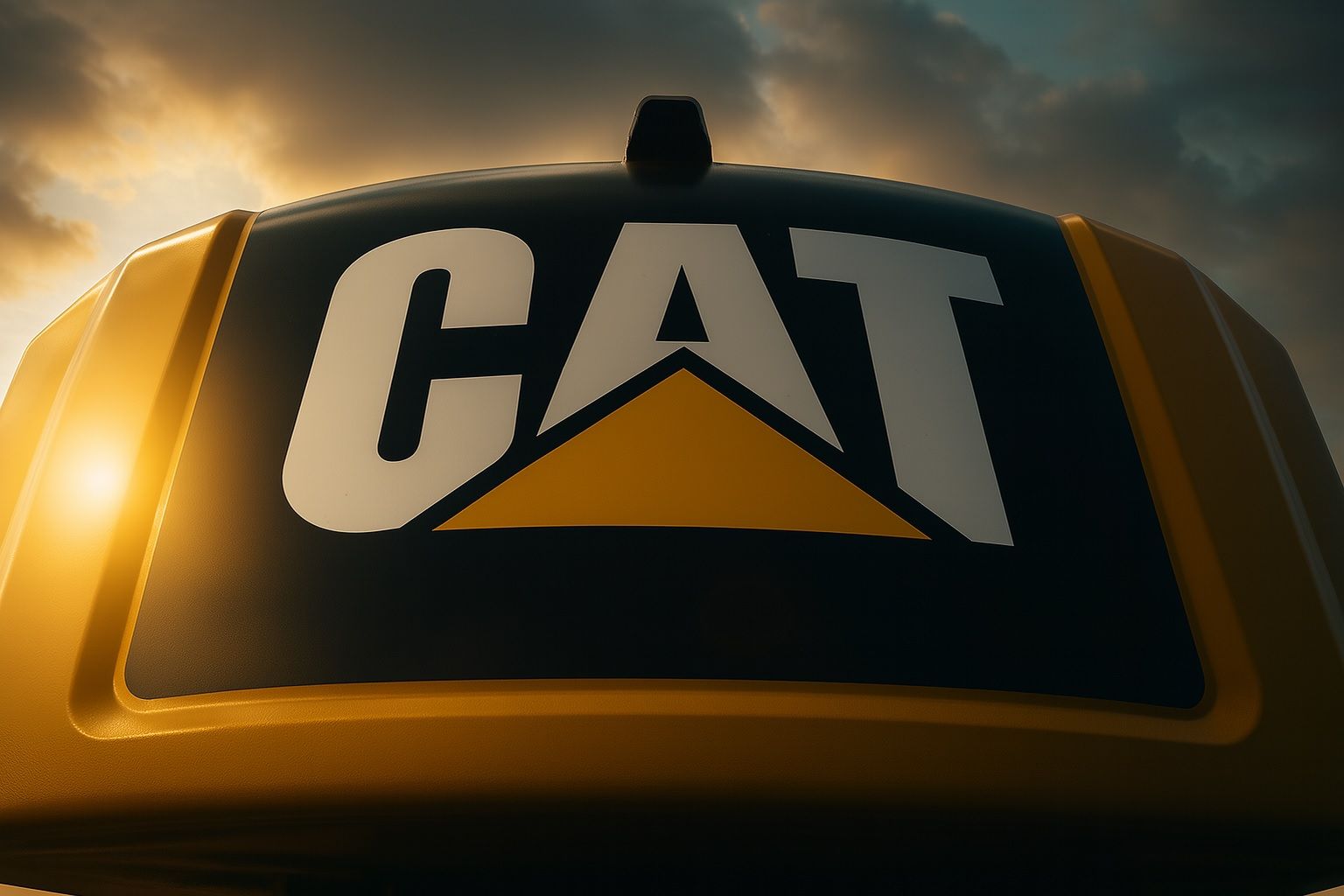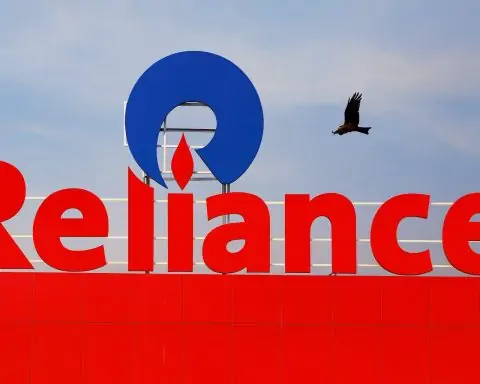- Shares Near All-Time High: CAT closed around the low-$520s on Oct. 28, 2025, after spiking to about $528 intraday [1] – roughly double its 52-week lows. Year-to-date gains are roughly +45–50%, far outpacing the S&P 500’s ~13% rise [2] [3].
- Big Pre-Market Rally: On Oct. 29, shares jumped about 5% in pre-market trading after Caterpillar’s Q3 results beat estimates [4], adding ~$10 billion to its market cap in one session [5]. Over the past week, the stock has shrugged off a late pullback and is back near record highs.
- Earnings and AI Demand: Caterpillar reported Q3 revenue of $17.6 billion (vs. $16.77 b expected) and adjusted EPS of $4.95 (vs. $4.52 b expected) [6] [7]. Its energy segment (generators, turbines, etc.) saw 17% sales growth ($7.2 b), led by AI data-center demand [8], while construction equipment sales rose 7% ($6.76 b) aided by higher prices [9]. Reuters noted a “boom in AI technologies [is] driv[ing] demand” for Caterpillar’s power systems [10].
- Strategic Deals Fuel Growth: Investors also cheered recent big deals. Caterpillar agreed to buy Australian mining-software firm RPMGlobal for ~$1.1 billion (cash) [11] and has struck major data-center power partnerships: a 1 GW Texas project with Hunt Energy [12] and a 4 GW Utah AI data center project with Joule Capital [13]. “Caterpillar is uniquely positioned to tackle the growing energy needs for artificial intelligence,” said a senior VP after the Utah deal [14].
- Analysts Signal Caution: Wall Street sentiment is mixed. Bulls point to the AI/data-center story and record backlog, but some caution on valuation. Morgan Stanley recently warned CAT is “priced for perfection,” downgrading it on signs of weakening construction demand [15]. Bernstein is neutral with a ~$502 target (below current levels [16]). On the optimistic side, JPMorgan upgraded CAT to Overweight with a $650 price target [17], and Bank of America, Baird and others have raised targets into the $600s. The average analyst target (~$497) still trails CAT’s price [18], suggesting limited upside without new catalysts.
- Macro Context: The broader market is strong. On Oct. 29 the Fed cut rates 25 bp to 3.75–4.00% [19], boosting the S&P 500 and Nasdaq to fresh highs (S&P ~6,891; Nasdaq ~23,827 on Oct. 28 [20]). AI-fueled gains in tech stocks have kept “the bulls… fully in charge,” analysts note [21]. However, high mortgage rates (~6.2% 30-year [22]) and a housing slump (sales near 30-year lows [23]) mean construction equipment demand may stay subdued. Tariff pressures and supply-chain costs have also been headwinds; management warned tariffs could cut ~$0.4–0.5 billion from Q3 profits [24].
Record Rally on Strong Demand and Big Upgrades
Caterpillar’s stock has been on fire. In mid-October, CAT surged on news of a major analyst upgrade and strategic announcements. On Oct. 14 the stock hit an intraday peak around $528.45, its highest-ever level [25]. “Today’s jump added roughly $10 billion to Caterpillar’s market value in a single session,” noted one market report [26]. Over the past year the shares have rallied from the mid-$200s to the mid-$500s, nearly doubling since their 52-week low [27] [28]. This has made CAT one of the Dow Jones’s top performers in 2025, outpacing even Nvidia and Microsoft [29].
Analysts credit this surge to a convergence of factors. JPMorgan Chase stunned the market by raising its price target to $650 (from $505) and keeping an Overweight (buy) rating [30]. Other Wall Street firms have also boosted their outlooks: for example, Baird set a $612 target (Buy) and Bank of America lifted its target to $594 (Buy). As one commentator put it, investors are riding a “perfect storm of strategic partnerships and technical momentum” [31]. Much of that momentum comes from Caterpillar’s push into high-growth areas: it’s now seen as a leader in providing power solutions to AI data centers and in selling advanced tech to miners.
AI, Energy Projects, and Major Deals
Caterpillar has actively sought out AI-related opportunities. In August it announced a long-term deal with Hunt Energy to deploy up to 1 GW of backup power for data centers (starting in Texas) [32]. In October it was one of the partners on Joule Capital’s plan to build a 4 GW power campus in Utah – a mammoth AI data center project [33]. The company’s Electric Power division says these contracts will use its latest generators, turbines, and battery storage to keep AI servers running around the clock.
Caterpillar also made a big move in digital mining. Over the weekend it agreed to buy RPMGlobal, an Australian mining software firm, for about $1.1 billion in cash [34]. The deal (approved by RPM’s board) will add mine-planning and asset-management software to Caterpillar’s offerings. “Their software solutions complement Caterpillar’s existing technologies,” said Denise Johnson, president of Caterpillar’s Resource Industries group, in announcing the acquisition [35]. Taken together, these deals signal that Caterpillar is evolving beyond yellow iron into software and clean energy infrastructure.
Q3 Beat and Short-Term Outlook
On Oct. 29, just ahead of the market open, Caterpillar reported third-quarter results that easily topped expectations. Revenue was $17.6 billion, beating the $16.77 billion consensus, and adjusted EPS came in at $4.95 vs. $4.52 expected [36] [37]. Energy & Transportation sales climbed 17% (to about $7.2 b), reflecting the strong demand for generators and turbines. Construction equipment sales rose 7% (to $6.76 b), helped by price increases. Shares jumped roughly 5% pre-market on the news [38], quickly pricing in this strong demand.
Management pointed out that AI-related spending is a big factor. As Reuters reported, the AI computing boom has “driven demand for [Caterpillar’s] energy equipment,” lifting data-center power orders [39]. Caterpillar’s president of E&T, Jason Kaiser, noted that 2024 was the first year the power-generation division out-earned the traditional construction division – underscoring the company’s pivot [40]. Investors will now watch the conference call and guidance. Caterpillar has said it expects 2025 revenue to be only slightly above 2024, with margins pressured by tariffs. Any signs of slowing construction demand (especially in China) or further cost inflation could temper the outlook.
Bullish Buzz vs. Valuation Concerns
Wall Street’s excitement is clear in the latest ratings. According to MarketBeat data, analysts now have nearly twice as many Buy/Overweight ratings as Holds, and the consensus price target is roughly $501 [41] (well below CAT’s current price). The bulls argue that Caterpillar is reaping both cyclical infrastructure spending and secular AI tailwinds. Bank of America notes that the Energy & Transportation segment (40% of sales) is “booming” thanks to data centers and renewables [42]. They, JPMorgan and others point to improving profit margins and strong cash flow as reasons to stay positive.
But cautionary voices are getting louder too. Morgan Stanley recently downgraded CAT to Underweight, warning that its fundamentals may weaken with the cyclical economy. Analyst Angel Castillo bluntly called the stock “priced for perfection” [43], emphasizing that any miss in construction or margins could trigger a pullback. Bernstein kept a neutral rating, noting that even with a raised price target (~$502) the stock wasn’t cheap [44]. Indeed, Caterpillar now trades at roughly 26x forward earnings, a level that many consider stretched [45].
Economic Backdrop and What’s Next
Caterpillar’s rally comes amid a broad market upswing. On Oct. 29 the Fed cut its benchmark rate by 25 basis points to a 3.75–4.00% range [46], and U.S. stocks hit new highs as investors welcomed easier monetary policy. The S&P 500 stood around 6,891 and the Nasdaq around 23,827 on Oct. 28 [47]. Tech giants (like Nvidia) also climbed, supporting the “Magnificent Seven” rally and lifting industrial stocks in sympathy. As one market memo put it, the bulls remain “fully in charge” on optimism about AI and Fed easing [48].
However, underlying risks persist. Mortgage rates remain elevated (~6.2% for a 30-year loan [49]), and home sales are near 30-year lows [50], keeping construction spending subdued. Caterpillar management has warned that tariffs on imported components could hit profits (they estimate ~$400–500 million of Q3 tariff costs) [51]. Recent data show U.S. business equipment borrowing jumped +8% in September [52], but higher financing costs could slow orders for heavy machinery.
Investors will get more clues soon. Caterpillar’s next major reports are the Nov. 4 earnings call and any updates in late-2025 guidance. Analysts will be listening for changes in order trends, pricing power, and costs. For now, CAT remains a standout on both the Dow and in the AI narrative. But its lofty price means even small disappointments could quickly reverse some of the recent gains.
Sources: News and data from Reuters, MarketScreener, Caterpillar press releases, and industry reports [53] [54] [55] [56] [57] [58]. These include the latest earnings releases, analyst notes, and market commentary.
References
1. ts2.tech, 2. ts2.tech, 3. www.investopedia.com, 4. www.reuters.com, 5. ts2.tech, 6. www.reuters.com, 7. www.reuters.com, 8. www.reuters.com, 9. www.reuters.com, 10. www.reuters.com, 11. ts2.tech, 12. ts2.tech, 13. ts2.tech, 14. ts2.tech, 15. www.investing.com, 16. ts2.tech, 17. ts2.tech, 18. www.investopedia.com, 19. ts2.tech, 20. ts2.tech, 21. ts2.tech, 22. ts2.tech, 23. ts2.tech, 24. ts2.tech, 25. ts2.tech, 26. ts2.tech, 27. ts2.tech, 28. www.investopedia.com, 29. www.investopedia.com, 30. ts2.tech, 31. ts2.tech, 32. ts2.tech, 33. ts2.tech, 34. ts2.tech, 35. ts2.tech, 36. www.reuters.com, 37. www.reuters.com, 38. www.reuters.com, 39. www.reuters.com, 40. ts2.tech, 41. ts2.tech, 42. www.investopedia.com, 43. www.investing.com, 44. ts2.tech, 45. ts2.tech, 46. ts2.tech, 47. ts2.tech, 48. ts2.tech, 49. ts2.tech, 50. ts2.tech, 51. ts2.tech, 52. www.marketscreener.com, 53. www.reuters.com, 54. ts2.tech, 55. ts2.tech, 56. ts2.tech, 57. www.investopedia.com, 58. www.investing.com







